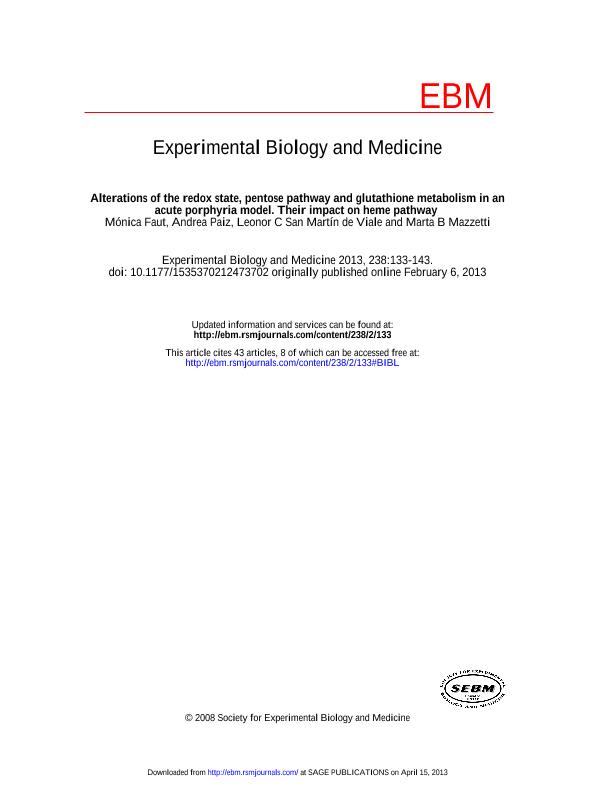Mostrar el registro sencillo del ítem
dc.contributor.author
Faut, Monica

dc.contributor.author
Paiz, Andrea
dc.contributor.author
San Martin, Leonor Carmen

dc.contributor.author
Mazzetti, Marta Blanca

dc.date.available
2017-07-18T19:47:47Z
dc.date.issued
2013-02
dc.identifier.citation
Faut, Monica; Paiz, Andrea; San Martin, Leonor Carmen; Mazzetti, Marta Blanca; Alterations of the redox state, pentose pathway and glutathione metabolism in an acute porphyria model. Their impact on heme pathway; Soc Experimental Biology Medicine; Experimental Biology And Medicine; 238; 2; 2-2013; 133-143
dc.identifier.issn
1535-3702
dc.identifier.uri
http://hdl.handle.net/11336/20854
dc.description.abstract
A classical acute porphyria model in rats consists of combined treatment with 2-allyl-2-isopropylacetamide (AIA) and 3,5-diethoxycarbonyl-1,4-dihydrocollidine (DDC). The present work describes the effects of this treatment on the pentose phosphate (PP) pathway, glutahione metabolism and redox state and how they contribute to alter the glucose pool of hepatocytes and modulate porphyria, in Wistar rat livers. Our approach is based on the fact that glucose is a repressor of 5-aminolevulinic synthase (ALA-S), the rate-limiting enzyme of the heme pathway, and treatment with AIA/DCC causes oxidative stress. Different doses of the xenobiotcs were used. The results show that AIA (500 mg/kg body weight [BW])/ DDC (50 mg/kg [BW]) treatment increased glutathione peroxidase (GPx) activity by 46%, decreased both glutathione reductase (GR) and glutathione S-transferase (GST) activity by 69% and 52%, respectively, and reduced by 51% reduced glutathione (GSH) and increased by 100% glutathione disulfide (GSSG) concentrations, therefore lowering by four-fold the GSH/GSSG ratio. The activity of glucose-6-phosphate dehydrogenase (G6PD), the rate-limiting enzyme of PP-pathway, was increased by 129% as well as that of 6-phosphogluconate dehydrogenase. NADPH and the NADPH/NADP+ ratio were increased by 14% and 28%, respectively. These effects could be attributed to the generation of reactive oxygen species (ROS) elicited by the porphyrinogenic treatment, shown by enhanced DNA damage and ROS production. G6PD stimulation would decrease hepatic glucose concentrations and consequently exacerbate the porphyria. A decrease in glucose could stimulate ALA-S and this would add to the effect of drug-induced heme depletion. Since the key role of GST is to inactivate toxic compounds, the drastic fall in its activity together with the accumulation of ALA would account for the symptoms of this hepatic disease model. The present findings show the high metabolic interplay between pathways and constitute a relevant contribution to achieve a better treatment of acute human porphyria.
dc.format
application/pdf
dc.language.iso
eng
dc.publisher
Soc Experimental Biology Medicine

dc.rights
info:eu-repo/semantics/openAccess
dc.rights.uri
https://creativecommons.org/licenses/by-nc-sa/2.5/ar/
dc.subject
Porphyria
dc.subject
Glutathione Metabolism
dc.subject
Reactive Oxygen Species
dc.subject
Pentose Pathway
dc.subject.classification
Otras Ciencias Biológicas

dc.subject.classification
Ciencias Biológicas

dc.subject.classification
CIENCIAS NATURALES Y EXACTAS

dc.title
Alterations of the redox state, pentose pathway and glutathione metabolism in an acute porphyria model. Their impact on heme pathway
dc.type
info:eu-repo/semantics/article
dc.type
info:ar-repo/semantics/artículo
dc.type
info:eu-repo/semantics/publishedVersion
dc.date.updated
2017-07-18T15:34:21Z
dc.identifier.eissn
1535-3699
dc.journal.volume
238
dc.journal.number
2
dc.journal.pagination
133-143
dc.journal.pais
Estados Unidos

dc.description.fil
Fil: Faut, Monica. Universidad de Buenos Aires. Facultad de Ciencias Exactas y Naturales. Departamento de Química Biológica; Argentina
dc.description.fil
Fil: Paiz, Andrea. Universidad de Buenos Aires. Facultad de Ciencias Exactas y Naturales. Departamento de Química Biológica; Argentina
dc.description.fil
Fil: San Martin, Leonor Carmen. Universidad de Buenos Aires. Facultad de Ciencias Exactas y Naturales. Departamento de Química Biológica; Argentina. Consejo Nacional de Investigaciones Científicas y Técnicas; Argentina
dc.description.fil
Fil: Mazzetti, Marta Blanca. Universidad de Buenos Aires. Facultad de Ciencias Exactas y Naturales. Departamento de Química Biológica; Argentina
dc.journal.title
Experimental Biology And Medicine

dc.relation.alternativeid
info:eu-repo/semantics/altIdentifier/doi/http://dx.doi.org/10.1177/1535370212473702
dc.relation.alternativeid
info:eu-repo/semantics/altIdentifier/url/http://journals.sagepub.com/doi/10.1177/1535370212473702
Archivos asociados
